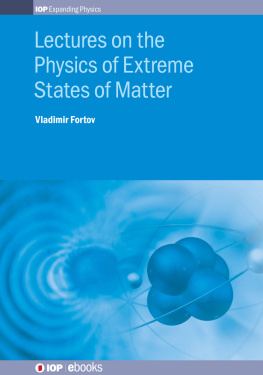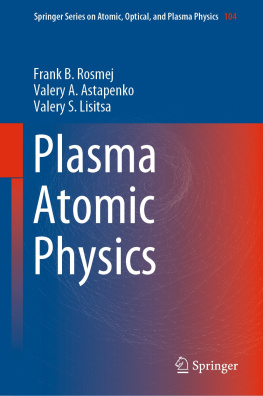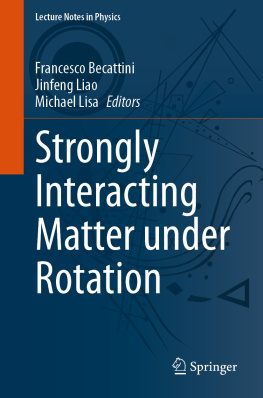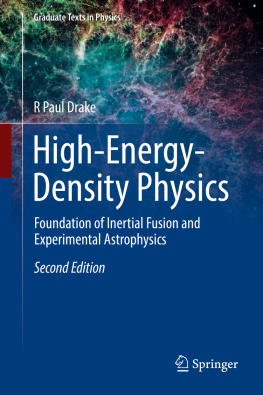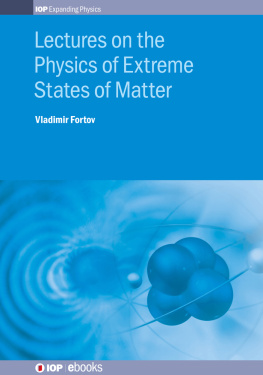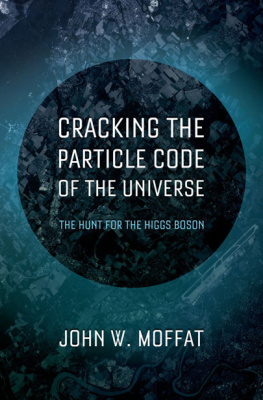Contents
Contents
Lectures on the Physics of Extreme States of Matter
Vladimir E Fortov
Joint Institute for High Temperatures, Moscow, Russia
IOP Publishing, Bristol, UK
IOP Publishing Ltd 2019
All rights reserved. No part of this publication may be reproduced, stored in a retrieval system or transmitted in any form or by any means, electronic, mechanical, photocopying, recording or otherwise, without the prior permission of the publisher, or as expressly permitted by law or under terms agreed with the appropriate rights organization. Multiple copying is permitted in accordance with the terms of licences issued by the Copyright Licensing Agency, the Copyright Clearance Centre and other reproduction rights organizations.
Permission to make use of IOP Publishing content other than as set out above may be sought at .
Vladimir E Fortov has asserted his right to be identified as the author of this work in accordance with sections 77 and 78 of the Copyright, Designs and Patents Act 1988.
ISBN 978-0-7503-2128-0 (ebook)
ISBN 978-0-7503-2126-6 (print)
ISBN 978-0-7503-2127-3 (mobi)
DOI 10.1088/2053-2563/ab1091
Version: 20190801
IOP Expanding Physics
ISSN 2053-2563 (online)
ISSN 2054-7315 (print)
British Library Cataloguing-in-Publication Data: A catalogue record for this book is available from the British Library.
Published by IOP Publishing, wholly owned by The Institute of Physics, London
IOP Publishing, Temple Circus, Temple Way, Bristol, BS1 6HG, UK
US Office: IOP Publishing, Inc., 190 North Independence Mall West, Suite 601, Philadelphia, PA 19106, USA
A word to the reader
You are holding a course of lectures from the Higher School of Physics series of ROSATOM State Corporation.
The Higher School of Physics is the initiative of ROSATOM, aimed at training and educating scientists of a new generation in the field of theoretical and experimental physics, as well as at attracting talented young people to science and innovation spheres.
The books of this series have been prepared by leading scientists of the Russian Academy of Sciences and industry research centers and contain information about the most topical areas of theoretical and experimental physics.
I hope these books will become handbooks for students and postgraduates of specialized disciplines, young scientists and all employees of the nuclear industry, interested in improving their scientific and technical skills.
For ROSATOM, the matter of honor and professional maturity is to breathe fresh energy into nuclear power engineering and industry: to cultivate a galaxy of physicists of the future, who will become generators of innovative ideas and drivers of the world nuclear industry.
V A Pershukov,
Deputy Director General for Innovation Management,
ROSATOM State Corporation
From the editorial board
The successful history of the nuclear project, which was of key importance for the stability of our country for many decades was the result of the work of a huge team of scientists, engineers and workers. The task of forging an atomic shield was solved in a country destroyed by war, at the cost of incredible efforts, without a developed instrument-making infrastructure, in the absence of necessary unique materials and the corresponding industry. Paying tribute to all participants of the project, particular mention should be made of the decisive contribution of scientists. Bright representatives of physical, chemical, and materials sciences found solutions to the most complicated problems that were on the way to creating nuclear weapons. We proudly remember I V Kurchatov, Yu B Khariton, I E Tamm, A D Sakharov, K I Shchelkin, D A Frank-Kamenetsky, V L Ginzburg, E I Zababakhin and many other prominent scientists who led their colleagues and students. Success was determined by the talent and a broad knowledge of the leaders. Even today, their successors and disciples successfully work in our industry, including civil and defense spheres.
Modern problems of the development of science and technology also call for scientific leaderscustodians of the traditions initiated by previous generations. The upbringing of such leaders is the main concern of ROSATOM. That is why an idea arose to found the Higher School of Physics for young employees of ROSATOM institutes. The main task of the Higher School of Physics is to broaden the horizons of young peoplestudents of the School by organizing four two-week modules on the basis of the largest scientific centers of ROSATOM, during which leading Russian scientists deliver lectures that represent different fields of physics and related sciences.
The selection of the courses and lecturers is made by the Scientific Council of the School. The Council includes well-known scientists from All-Russian Scientific Research Institute of Technical Physics (Snezhinsk), All-Russian Scientific Research Institute of Experimental Physics (Sarov), Troitsk Institute for Innovation and Fusion Research (Troitsk), and Institute of Physics and Power Engineering (Obninsk). Each course consists of six lectures; two courses are read each week; and the number of students is no more than 20 people, which creates prerequisites for direct contact of the lecturer with the audience.
It is important that students attend the courses only twice a year for two weeks. Young employees, who showed their qualities as researchers and leaders, are selected to join the School by the heads of the institutes.
The present series has been prepared on the basis of the lecture materials of the Higher School of Physics. The Scientific Council of the School expresses the hope that the series will appeal to a wide readership who wish to become acquainted with a brief summary of selected chapters of modern physics.
V P Smirnov,
Academician of the Russian Academy of Sciences,
Chairman of the Scientific Council of the Higher School of Physics of ROSATOM State Corporation,
Chairman of the Editorial Board of the series
Authors preface
This book is based on the lectures delivered by the author at the Higher School of Physics founded by ROSATOM State Corporation, as well as on plenary, review and invited papers presented at scientific conferences and symposia.
I am grateful for the opportunity to acquaint students of the School with the current state and prospects for the development of the physics of extreme states of matter, with the advantages and limitations of various experimental methods of generation and diagnostics, and with the results achieved.
In this course, the author has made an attempt to systematize, summarize and present, from a single point of view, theoretical and experimental material relating to this new field of science. In addition to the extensive scientific literature, the author has used a large number of original papers, reports and abstracts that are not widely available to a wide audience.
In view of the vastness and dissimilarity of the material, the presentation is mainly of a fact-finding nature, referring the reader to relevant reviews and monographs. Therefore, many interesting astrophysical, laser and nuclear physics problems, as well as technical applications, are presented briefly, sometimes even schematically. The author, of course, did not set a goal to include everything that is known today about extreme states of matter. The emphasis is laid particularly on those issues that seem most interesting to the author and on which he and his colleagues had to work directly.

